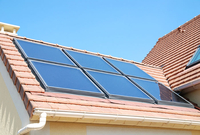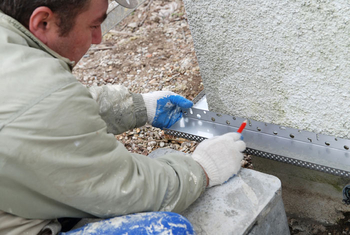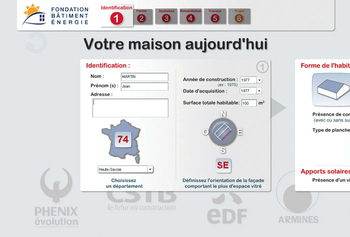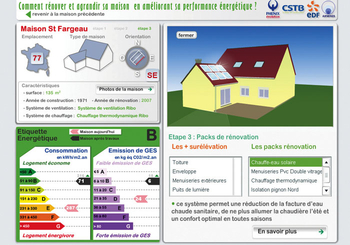For « Factor 4 » rehabilitation of detached houses

The project presented by Phénix Evolution received its award in December 2008 during the 4th edition of the Innovative Houses Challenge attended by almost 400 Building professionals. Phénix Evolution was a competitor in the “Renovated House” category open to house renovation projects offering an increase in floor area, aesthetic improvements and especially an improvement in energy performance, and it presented the Saint-Fargeau-Ponthierry rehabilitation project, the first project appraisal supported by the Building Energy Foundation, called ODMIR4 (Outil d’aide à la Décision pour les Maisons Individuelles Réhabilitées – Decision-making assistance tool for rehabilitated detached houses). The purpose of this research project is to develop and promote a methodology for renovation of detached houses. “This program brings together four partners, says CSTB's Mireille Jandon, namely CSTB, Armines, EDF R&D and Phénix Evolution. The owners of tens of thousands of Phénix houses built in France are potentially concerned by this first phase."
So what is this renovation? Its objective is a complete rehabilitation of a first generation house (1971) with a substantial resulting reduction in the energy factor. The useful floor area was increased from 86 sq m to 136 sq m by increasing the height of the building and the consortium involved in the project suggested a set of technical solutions that can be industrialised and were implemented, including external insulation, replacement of door and window frames, air/air heat pump, double flow ventilation with heat exchanger, solar hot water heater. CSTB made permeability measurements and infra-red images when the site was accepted, to check the effective quality of this building. Complete monitoring of consumption was planned for over two years.
A decision making and specification assistance tool
"The software developed will be supported by Phénix sales-engineers, continues Mireille Jandon. It is intended to be simple and pedagogic. A few clicks are sufficient to demonstrate the advantage to owners concerned by home improvements, of approaching the work under the angle of energy performance. Package solutions are proposed, and the potential costs and benefits of the recommendations are given." In its final version to be released during 2009, the computer application will become a genuine decision-making assistance tool, and it will provide immediate information about the resulting change in energy class of the house. It will also be possible to propose consistent work packages (for example no outside insulation without appropriate ventilation) and that can be isolated to adapt to all budgets. Technical datasheets (what is a heat pump?, a solar water-heater?, etc.) will be available, with a list of financial incentives that can be used to complete the works. It will then be time to envisage transposing this tool to all detached houses.


A credible approach
"Enlargement, face lifting, roof repair, etc.: many different types of work are envisaged by Phénix house owners. The software derived from the ODMIR 4 program makes use of these requests to provide a means of approaching these projects from an energy performance point of view. For example, why not envisage external insulation at the same time as giving the building a face lift? The tool is well accepted by our customers and by our salesmen, because it increases confidence in the approach. It provides a guarantee that the intrinsic performance of the building will be achieved, while the effective performance depends on use and the weather. The tool displays the difference between the initial energy label of the house and the energy label that can be expected after the work, the change in class of houses appearing very clearly. The easy use of this software (no need for training) and its pedagogic aspect for owners were unanimously appreciated."
Olivier de Lattre, development manager, Phénix Evolution.


